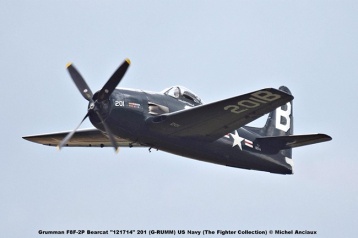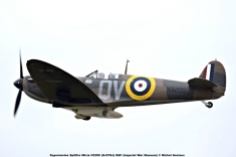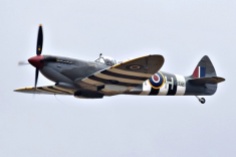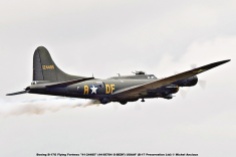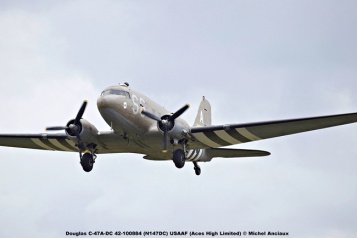Translation in english available at the bottom
La presencia de 5 Hispano Buchón recordaba también 50 año de la presentación de la película ‘’la batalla de Inglaterra’’ en salas de cine a través del país en septiembre de 1968.
Hispano HA-1112-M1L Buchon »Yellow 7» (G-AWHM) Luftwaffe (Air Leasing Ltd)
Hispano HA-1112-M1L Buchon »White 5» Luftwaffe (G-AWHR) (Air Leasing Ltd)
Hispano HA-1112-M1L Buchon »Yellow 10» (G-BWUE) Luftwaffe (Historic Flying Ltd)
Hispano HA-1112-M4L Buchon »Red 11» (G-AWHC) Luftwaffe (Air Leasing Ltd)
El Ha-1112-M1L con numero 9 pintado de blanco (matricula G-AWHH) fue uno de los 27 Buchón comprados en 1968 por Spitfire Production para ser utilizados en la filmación de la película (Solo 17 volaron actualmente) recordando la epopeya de esta batalla ocurrida entre julio de 1940 y mayo de 1941 en la cual se enfrentaron principalmente los Spitfire y Hurricane ingleses con los aviones alemanes Messerschmitt BF 109 de caza pero también los bombarderos Heinkel He 111, Junkers Ju 88, Dornier Do 17 y Messerschmitt 110.
Este Buchón está adornado con los colores del Bf 109F-4 del Unteroffizier (Sargento 1°) Edmund Rossmann con 93 victorias aéreas participando en la batalla de Francia, la de Inglaterra y también operación Barbarossa.
Ciertas presentaciones en vuelo se relacionaban a temas. Ultimate Fighters Team estaba compuesto de los Republic P-47D Thunderbolt, North American TF-51D-25 Mustang »44-14251’’, Supermarine Spitfire MK Vc y el Hispano HA-1112-M1L Buchón »White 9».
»Battle of Britain» formation por su parte llevaba tres Spitfire, el Westland Lysander Mk.IIIA y el Bristol Blenheim Mk.I.
»The Curtiss Aircraft Quarter» presentó los Curtiss P-36C, H-75A-1, Curtiss-Wright P-40C y P-40F Warhawk.
»The Classic Formation» con el Douglas DC-3C-S1C3G N431HM Swissair (Aircraft Guaranty Corp Trustee) y 3 Beech 18.
Otros temas presentados fueron los de The Navy Tribute con los Grumman Wildcat y Bearcat, Sea Fury y el PBY Catalina,
y Flying Legends con tres Douglas C-47 y dos Piper L-4 Cub.
15 Supermarine Spitfire participaron en la presentación en vuelo y lo destacado era que 7 tenían antecedentes de participaciones en combate en la segunda guerra mundial.
A continuación les propongo un histórico de estos aviones:
Supermarine Spitfire Mk.VB BM597 JH-C (G-MKVB) de Historic Aircraft Collection Ltd fue entregado en mayo de 1942 al escuadrón 315 pasando luego al escuadrón 317 los 2 con base en Woodvale.
Los colores y código de identificación ‘’JH’’ de escuadrón que lleva hacen referencia al escuadrón de caza polaco 317 Wilenski (la ciudad de Vilna en Lituania anexada en 1939 por los soviéticos a este país) que participo en ofensivas sobre el territorio alemán y Francia, así que protección de bombarderos. También participo en operaciones de protección y apoyos en el D-Day.
Supermarine Spitfire MK Vc EE602 DV-V (G-IBSY) Anglia Restorations Ltd inició sus operaciones con el escuadrón 66 siendo este el segundo en operar el Supermarine Spitfire y participó en la batalla de Inglaterra (1940-1941) pero sus primeras inicios de combates fueron en Dunkirk en mayo-junio de 1940.
Este escuadrón tuvo como base Duxford, de julio 1938 hasta mayo de 1940.
Lleva los colores y código de identificación de escuadrón ‘’DV’’ del escuadrón 129.
Este escuadrón participó en protección de los vuelos de bombarderos hacia los territorios ocupados de Europa, operaciones en el D-Day- desembarque de Normandía y destrucciones de los cohetes V-1. También participó en ataques de barcos alemanes.
‘’Central Railways Uruguyan staff’’ hace referencia a la recolección de fondos obtenida por esta compañía a través de la venta de bonos de guerra (War Bonds).
EE602 efectuó más de 100 misiones, una de la más destacada siendo escoltar el Boeing B-17 ‘’Memphis Belle’’ luego de su 25ª misión.
Supermarine Spitfire LF Mk.Vb EP120 AE-A (G-LFVB) The Fighter collection tiene 7 aviones derivado a su crédito siendo este el avión con más victoria en combates aun en vuelo en el mundo.
Fue entregado a la Real Fuerza Aérea de Inglaterra en mayo de 1942 y asignado primero al escuadrón 501 donde marcó 6 de sus confirmadas victorias. Paso al escuadrón 19 y finalmente en abril de 1944 al 402 ‘’City of Winnipeg’’ de la Real Fuerza Aérea de Canadá por solo 2 meses.
Paso por un tiempo de material de instrucción, también en la puerta de guardia de unas bases aéreas.
En 1967 participó como modelo estático en la filmación de la película ‘’la batalla de Inglaterra’’
Buscando en la red más datos sobre este avión, salieron informaciones sobre los tipos de aviones derivados y fechas. Primero se anota un Dornier Do 17 mientras el Spitfire operó con el escuadrón 501. Luego, operando con el 402 canadiense y con el Sqn Leader Jeff Nortcott se sumó otros aviones derivados: tres Messerschmitt BF.109 derivados y un dañado así que tres Focke-Wulf 190 también derivados.
Supermarine Spitfire Mk. IX MH434 ZD-B (G-ASJV) Merlin Aviation Company fue parte del escuadrón 222 donde logro derivar 7 aviones enemigos y dañar 3 otros todos al crédito del piloto sud africano Flt. Lt. Henry Lardner-Burke, DFC.
Luego de cumplir 79 operaciones, el Spitfire MH434 fue retirado del servicio en marzo de 1945.
Operó también con la Real Fuerza Aérea Holandesa y la Fuerza Aérea Belga hasta 1956 cuando volvió a Inglaterra, con matrícula civil G-ASJV. Participó también en la filmación de ‘’La batalla de Inglaterra’’.
Lleva los colores y código de letras ‘’ZD’’ del escuadrón 222 de la Real Fuerza Aérea de Inglaterra.
Este escuadrón de caza participó en la evacuación de Dunkirk protegiendo los barcos, la batalla de Inglaterra y por supuesto las operaciones relacionadas con el desembarque en Normandía.
Supermarine Spitfire Mk IX T ML407 (G-LFIX) Air Leasing Ltd fue entregado a principio de 1944 como versión monoplaza y participo en operaciones de batallas en los 12 últimos meses de la segunda guerra mundial totalizando 176 combates. Fue en los controles de este avión que el Flying Officer Johnnie Houlton, DFC fue acreditado con el primero avión enemigo derivado sobre las playas de Normandía el 6 de junio de 1944 (Un Junkers Ju 88).
En 1950 el ML407 fue convertido en una versión de 2 plazas para ser operado con el Irish Corp en entrenamientos avanzados.
Este Spitfire lleva los colores del escuadrón 485 de la Real Fuerza aérea de Inglaterra.
Supermarine Spitfire Mk.Ia N3200 (G-CFGJ) Imperial War Museum fue entregado en abril de 1940 al escuadrón 19 con base en Duxford pero su carrera fue de corta vida debido a que fue derribado.
Sumergido por el mar y arena los restos del avión fueron descubiertos y recuperados en 1986.
Su propietario actual lo trajo a Duxford en 2000 para su reconstrucción a manos de Historic Flying Ltd. realizando su primero vuelo post restauración el 26 de marzo de 2014.
Lleva los colores y código de letras ‘’QV’’ del escuadrón 19 de la Real Fuerza Aérea Inglesa.
Supermarine Spitfire TR.9 PV202 5R-H (G-CCCA) Aircraft Restoration Company fue armado como modelo monoplaza y entro en servicio activo en octubre de 1944 con el escuadrón 33 de la Real Fuerza Aérea Inglesa con su base en Merville, Francia llevando el código 5R-Q en operaciones de apoyo aéreo para operaciones ofensiva terrestre. También practico ataques a tropas enemigas y líneas de comunicaciones o convoyes ferroviarios.
PV202 se trasladó a su nueva base en Maldegem, Bélgica (Unos 15 km al este de Brujas) antes de volver al Reino Unido en diciembre de 1944 debido a que el escuadrón se convirtió al Hawker Tempest.
El 4 de mayo de 1945 el PV202 realizó su última operación y con el final de la guerra el escuadrón 412, al cual pertenecía el avión, volvió a Inglaterra para pasar luego a almacenamiento.
En 1950 fue seleccionado para conversión en avión de entrenamiento para el Irish Corp y ser entregado a Irlanda el 15 de junio de 1951 siendo utilizado para formación de los pilotos del Seafire siendo retirado del servicio en 1960 y utilizado como material de instrucción para la escuela de formación técnica en Baldonnel.
Cumplió este trabajo hasta su venta para ser utilizado como posible reserva en la filmación de la película ´´la Batalla de Inglaterra’’.
Luego de su venta en 1979 y trabajo de restauración como avión de 2 asientos y utilizado en presentación aéreas. Lastimosamente el 8 de abril de 2000 en un vuelo de entrenamiento a mano de su nuevo dueño y con un instructor, el avión se accidento cobrando la vida a los 2 pilotos.
Terminando la investigación los restos fueron puestos a la venta y en marso de 2005 el avión realizó su primer vuelo post reconstrucción.
Para contribuir a las celebraciones de los 70 año de la batalla de Inglaterra en 2010, el avión apareció con una nueva pintura sustituyendo así los colores de la Real Fuerza Aérea Neerlandesa.
Fue pintado para representar el Spitfire X4474 del escuadrón 19 con base en Duxford.
Los otros Spitfire que participaron en los vuelos de presentaciones fueron:
Supermarine Spitfire MkVc JG891 TB (G-LFVC) Comanche Fighters LLC
Vickers Armstrong Spitfire FR XIV MV268 JE-J (G-SPIT) Anglia Aircraft Restorations Ltd.
Supermarine Spitfire MkIa P7308 XR-D (G-AIST) Spitfire The One Ltd.
Supermarine Spitfire PRXI PL983 (G-PRXI) Aircraft Restoration Company
Supermarine Spitfire Tr-9 PT462 SW-A (G-CTIX) Aircraft Restoration Company
Supermarine Spitfire Mk XVIII SM845 (G-BUOS) Spitfire Ltd
Supermarine Spitfire Mk XVI TD248 CR-S (G-G-OXVI) Spitfire Ltd
Supermarine Spitfire Mk.1 X4650 KL-A (G-CGUK) Commanche Warbirds
Por supuesto no podemos olvidar la presencia del Boeing B-17G Flying Fortress »41-24485» Sally B recordado por su participación en la película “Memphis Belle”.
El Consolidated PBY-5A Catalina »44-33915» (G-PBYA) USAAF.
Los Douglas DC-3/C-47 en colores del D-Day-desembarque de Normandía.
Los Curtiss también tienen referencias de sus participaciones en combates en la segunda guerra mundial.
Curtiss-Wright P-40C 10AB160 (G-CIIO) The Fighter Collection presto servicio con el Army Air Corp entre abril y diciembre de 1941 y utilizado en la zona de Puerto Rico para patrullas costeras y anti submarinas para luego ser despachado a la Unión Soviética como parte del Lend Lease Program.
Lastimosamente no existen por el momento datos de sus operaciones en Rusia pero fue adquirido, en muy mal estado, en los años noventa por the Fighter Collection.
Los colores que lleva son las de un P-40 39-159 que sirvió con el Technical Training Command en Chanute Field, Illinois, U.S.A en 1940 y la insignia “Sustineo Alas” significa “Mantenlos volando”.
Curtiss-Wright P-40F Warhawk »X-17» (G-CGZP) The Fighter Collection fue construido en la planta de Buffalo a finales de 1942 y fue enviado a la 13ª Air Force en el Pacifico Sudoccidental pero sus datos de operaciones son lastimosamente escasos igual si los únicos P-40F que combatieron en esta zona lo hicieron con los escuadrones de caza 44 y 68 en las Islas Solomon entre noviembre 1942 y octubre 1943. Termino abandonado en la isla de Espiritu Santo (archipiélago de Vanuatu).
Fue recuperado en los años 70 y al ser comprado por the Fighter Collection una restauración completa termino en 2011 con su vuelo de prueba siendo en abril del mismo año.
Por no tener las informaciones suficientes relacionadas con sus operaciones de guerra, lleva las pinturas ‘’Lee’s Hope’’ de un P-40 del escuadrón de caza 85 con base en Capodichino, Italia en 1944.
Curtiss H-75A-1 »82» (G-CCVH) The Fighter Collection fue uno de los 100 de un primero pedido producido para la Fuerza Aérea Francesa, llegando a Europa en abril de 1939.
Operando con la 1ra escuadrilla, grupo de combate 11/5 Lafayette con base en Reims como avión personal del comandante Murtin, oficial al mando de los grupos GC 1/5 y GC 11/5.
En la campaña de Francia paso primero por la base de Toul antes de ser transferido a Oran en Argelia. Entre 1940 y 1942 el escuadrón enfrento esporádicas escaramuzas con aviones de la Real Fuerza Aérea y Marina de los EE.UU sobre Argelia, Marueco y Túnez.
Al finalizar la guerra, n°82 fue utilizado como avión de entrenamiento en Francia.
Luego de haber sido almacenado en los años 50 fue comprado por The Fighter Collection en 1995 y luego de une revisión completa apareció en los show aéreos por primera en 2005.
A continuación les presento una galería de fotos de aviones que también participaron en estas presentaciones en vuelo.
Goodyear (Chance Vough) Corsair FG-1D KD345 (G-FGID) British Fleet Air Arm (The Fighter Collection)
North American P-51D-25 KH774 GA-S (44-73877 G-SHWN) RAF (Norvegian Spitfire Foundation)
North American TF-51D-25 Mustang »44-14251» (44-84847 G-TFSI) USAAF (Anglia Aircraft Restoration Limited)
Republic P-47D Thunderbolt »45-49192» F4-J (G-THUN) USAAF (The Fighter Collection)
Michel Anciaux
Documentations
http://www.historyofwar.org/air/units
http://fighter-collection.com/cft/curtiss-p-40f-warhawk/
Aircraft Restoration
The Fighter Collection
Anglia Aircrfat Restoration
Aces High
Aviation Rainbows wishes to express his thanks to the press and public relation department of the Imperial War museum for allowing me to do this report giving the corresponding access and in the best conditions of securities.
Aviation Rainbows quiere expresar sus agradecimientos al departamento de prensa y relaciones publicad del Imperial War Museum por permitir me hacer este reportaje facilitándome los accesos correspondientes y en las mejores condiciones de seguridades.
The presence of five Hispano Buchón also recalled 50 years of the presentation of ‘’ the battle of Britain’’ in movie theatres across the country, in September 1968.
For example, the Ha-1112-M1L, with number 9 painted white (registration G-AWHH), was one of 27 Buchón purchased in 1968 by Spitfire Production to be used in the filming of the movie (Only 17 currently flew) recalling the epic of this battle that took place between July 1940 and May 1941, in which the British Spitfire and Hurricane faced the German fighter Messerschmitt BF 109 but also the Heinkel He 111, Junkers Ju 88, Dornier Do 17 and Messerschmitt 110 bombers .
This Buchón is adorned with the colours of Bf 109F-4 of Unteroffizier (1st Sergeant) Edmund Rossmann with 93 victories while participating in the battle of France, that of England and also operation Barbarossa.
Certain flight presentations were related to topics. Ultimate Fighters Team was composed of the Republic P-47D Thunderbolt, North American TF-51D-25 Mustang »44 -14251’’, Supermarine Spitfire MK Vc and the Hispanic HA-1112-M1L Buchón’ ‘White 9’ ‘.
» Battle of Britain » formation on the other hand carried three Spitfire, the Westland Lysander Mk.IIIA and the Bristol Blenheim Mk.I.
« The Curtiss Aircraft Quarter » introduced the Curtiss P-36C, H-75A-1, Curtiss-Wright P-40C and P-40F Warhawk.
Other topics presented were those of The Navy Tribute with The Grumman Wildcat and Bearcat, Sea Fury and PBY Catalina, and Flying Legends with three Douglas C-47 and two Piper L-4 Cub.
» The Classic Formation » with the Douglas DC-3C-S1C3G N431HM Swissair (Aircraft Guaranty Corp Trustee) and 3 Beech 18.
15 Supermarine Spitfire participated in the flight presentation and the highlight was that 7 of them had a history of combat in World War II.
Below I propose a history of these planes:
Supermarine Spitfire Mk.VB BM597 JH-C (G-MKVB) of Historic Aircraft Collection Ltd was delivered in May 1942 to sq. 315 then moving to sq. 317, both based in Woodvale.
The colours and identification code « JH » of the sq. that it carries refer to the Polish fighter squadron 317 Wilenski (the city of Vilnius in Lithuania annexed in 1939 by the Soviets to this country) that participated in offensives on German territory and France, as well as bomber aircraft protection. It also participate in protection operations and support on D-Day.
Supermarine Spitfire MK Vc EE602 DV-V (G-IBSY) Anglia Restorations Ltd began operations with sq. 66 being this the second to operate the Supermarine Spitfire and participated in the battle of Britain (1940-1941) but its first fighting operations were in Dunkirk in May-June 1940.
This squadron was stationed in Duxford, from July 1938 until May 1940. It carries the colours and squadron identification code ‘’ DV ’’ of sq. 129.
Squadron 129 participated in the protection of bombers aircraft to the occupied territories of Europe, operations in the D-Day – landing of Normandy and destruction of the V-1 rockets. He also participated in attacks on German ships.
Central ’Central Railways Uruguyan staff’ ’refers to the recollection of funds obtained by this company through the sale of war bonds.
EE602 carried out more than 100 missions, one of the most prominent being escorting the Boeing B-17 ’Memphis Belle’ after its 25th mission.
Supermarine Spitfire LF Mk.Vb EP120 AE-A (G-LFVB) The Fighter collection has 7 aircraft victories to its credit, this being the plane with the most victory in combats still in flight condition around the world.
It was delivered to the Royal Air Force in May 1942 and first assigned to sq. 501 whereit scored 6 of his confirmed victories. it moved to sq. 19 and finally in April 1944 to 402 ’City of Winnipeg’ of the Royal Canadian Air Force for only 2 months.
It became a ground instructional material for a while, also at the gate guardian of a few air force bases.
In 1967 It participate as a static model in the filming of the movie ‘’ the Battle of Britain ’’
Searching the network for more data about this aircraft, information on the types of aircraft shot down came out. First, a Dornier Do 17 is scored while the Spitfire operated with the 501 squadron Then, operating with the Canadian 402 and with the Sqn Leader Jeff Nortcott, other planes shot down were added: three Messerschmitt BF.109 shot down and one damaged so as three Focke -Wulf 190 also shot down.
Supermarine Spitfire Mk. IX MH434 ZD-B (G-ASJV) Merlin Aviation Company was part of the 222 squadron where it managed to score 7 enemy planes and damage 3 others all to the credit of the South African pilot Flt. Lt. Henry Lardner-Burke, DFC.
After completing 79 operations, the Spitfire MH434 was remove from service in March 1945.
it also operated with the Royal Dutch Air Force and the Belgian Air Force until 1956 when he returned to England, with civil registration G-ASJV. It also participate in the filming of ‘’ The Battle of Britain ’’.
It carries the colours and code letters ‘’ ZD ’’ of the 222 squadron of the Royal Air Force.
This fighter squadron participated in the evacuation of Dunkirk protecting the ships, the battle of britain and of course the operations related to the landing in Normandy.
Supermarine Spitfire Mk IX T ML407 (G-LFIX) Air Leasing Ltd was delivered at the beginning of 1944 as a single-seat version and participated in fighter operations in the last 12 months of World War II totalling 176 fights. It was at the controls of this plane that the Flying Officer Johnnie Houlton, DFC was credited with the first enemy aircraft shot down on the beaches of Normandy on June 6, 1944 (A Junkers Ju 88).
In 1950 the ML407 was converted into a 2-seats version to be operated with the Irish Corp in advanced training.
This Spitfire carries the colours of the 485 squadron of the Royal Air Force.
Supermarine Spitfire Mk.Ia N3200 (G-CFGJ) Imperial War Museum was delivered in April 1940 to Squadron 19 based in Duxford but his career was short-lived as it was shot down.
Submerged by the sea and sand the remains of the plane were discovered and recovered in 1986.
Its current owner brought it to Duxford in 2000 for reconstruction at the hands of Historic Flying Ltd. making its first post-restoration flight on March 26, 2014.
It carries the colours and code letters ‘’ QV ’’ of the squadron 19 of the Royal Air Force.
Supermarine Spitfire TR.9 PV202 5R-H (G-CCCA) Aircraft Restoration Company was built as a single-seat model and entered active duty in October 1944 with Squadron 33 of the Royal Air Force with its base in Merville, France caring the 5R-Q code in air support operations for ground offensive attacks. It also made attacks on enemy troops and communications lines or rail convoys.
PV202 moved to its new base in Maldegem, Belgium (about 15 km east of Bruges) before returning to the United Kingdom in December 1944 due to the squadron being converted to the Hawker Tempest.
On May 4, 1945, the PV202 carried out its last operation and with the end of the war the 412 squadron, to which the plane belonged than, returned to England for storage.
In 1950 it was selected for conversion into a training aircraft for the Irish Corp and delivered to Ireland on June 15, 1951 being used for training Seafire pilots, being retired from service in 1960 and used as instructional material for the school of technical training in Baldonnel.
It completed this work until its sale to be used as a possible reserve in the filming of the movie «The Battle of Britain».
After its sale in 1979 and restoration work as a 2-seat aircraft it was used in aerial presentations. Unfortunately, on April 8, 2000, on a training flight in the hand of its new owner and with an instructor, the plane crashed, killing the 2 pilots.
Finishing the investigation the remains were put up for sale and in March 2005, the plane made its first post reconstruction flight.
To contribute to the celebrations of the 70th year of the battle of Britain in 2010, the plane appeared with a new painting thus replacing the colours of the Royal Dutch Air Force.
It is painted to represent the Spitfire X4474 of Squadron 19 based in Duxford.
The other Spitfire that participated in the presentation flights were:
Of course, we cannot forget the presence of the Boeing B-17G Flying Fortress » -24485 » Sally B remembered for his participation in the movie “Memphis Belle”
The Consolidated PBY-5A Catalina » 44 -33915 » (G-PBYA) USAAF
The Douglas DC-3 / C-47 in colours of the Normandy D-Day-landing.
The Curtiss also have references to their participation in fighting in World War II.
Curtiss-Wright P-40C 10AB160 (G-CIIO) The Fighter Collection served with the Army Air Corp between April and December 1941, was use in the Puerto Rico area for coastal and anti-submarine patrols, and then dispatched to the Soviet Union as part of the Lend Lease Program.
Unfortunately, there are currently no data on its operations in Russia but it was acquired, in very bad condition, in the 1990s by the Fighter Collection.
The colours he wears are those of a P-40 39-159 that served with the Technical Training Command in Chanute Field, Illinois, U.S.A. in 1940 and the “Wings Sustineo” badge means “Keep them flying”.
Curtiss-Wright P-40F Warhawk » X-17 » (G-CGZP) The Fighter Collection was built at the Buffalo plant in late 1942 and was sent to the 13th Air Force in the Southwest Pacific. However, its operational data they are pitifully scarce but the only P-40F who fought in this area did so with fighting sq. 44 and 68 in the Solomon Islands between November 1942 and October 1943. Abandoned on the island of Espiritu Santo (Vanuatu archipelago).It was recovered in the 70s and when it was bought by the Fighter Collection a complete restoration was completed in 2011 with its test flight being in April of the same year.
For not having enough information related to his war operations, he carries the paintings ‘’ Lee’s Hope ’’ from a P-40 of the 85th fighting squadron based in Capodichino, Italy in 1944.
Curtiss H-75A-1 » 82 » (G-CCVH) The Fighter Collection was one of 100 of a first order produced for the French Air Force, arriving in Europe in April 1939.
Operating with the 1st squadron, fighting group 11/5 Lafayette based in Reims as Commander Murtin’s personal aircraft, commanding officer of the GC 1/5 and GC 11/5 groups.
In the campaign of France, he first passed through the base of Toul before being transferred to Oran in Algeria. Between 1940 and 1942 the squadron faced sporadic skirmishes with planes of the Royal Air Force and US Navy over Algeria, Morocco and Tunisia .
At the end of the War it was used as a training plane in France.
After being stored in the 50s, it was bought by The Fighter Collection in 1995 and after a complete review it appeared on the air shows for the first time in 2005.
Below I present a photo gallery of planes that also participated in these presentations in flight.
Michel Anciaux
Aviation Rainbows wishes to express his thanks to the press and public relation department of the Imperial War museum for allowing me to do this report giving the corresponding access and in the best conditions of securities.


























